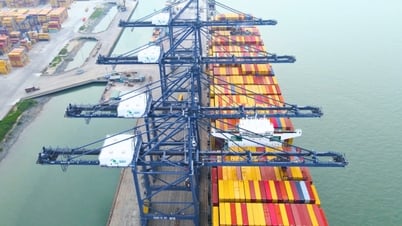How does the US calculate taxes?
Talking about the different tax rates that the US imposes on countries, economic expert, Associate Professor, Dr. Ngo Tri Long, commented that the US has a reciprocal tax formula imposed on countries of 1/2 x trade deficit/export value of that country to the US.
For example, according to the US announcement, Vietnam's exports to this country are 136.6 billion USD and in return Vietnam buys goods from the US is 13.1 billion USD. The US has a trade deficit of 123.5 billion USD, equivalent to a rate of 90%. Thus, the US chooses a reciprocal tax rate of about 1/2 of the above rate but chooses a higher rate of 46% (instead of 45%).
For example, Cambodia exports 12 billion USD to the US and imports 0.3 billion USD from the US. The US trade deficit with Cambodia is 11.7 billion USD, equivalent to 97.5% and the US imposes a reciprocal tax on Cambodia at 49%.
Indonesia's exports to the US are worth 28 billion USD, and its imports are worth 10.1 billion USD, so the trade deficit is 17.9 billion USD, equivalent to 64%, so the US imposes a reciprocal tax on this country of 34%...

US President Donald Trump announced reciprocal tariffs on April 2 at the White House (Photo: Reuters)
Unfair to Vietnam
Commenting on this tax calculation method, Mr. Mac Quoc Anh - Vice President of the Hanoi Association of Small and Medium Enterprises (Hanoisme) said that the US is currently relying on an unfavorable, non-objective reasoning method that does not accurately reflect the reality of production and business in Vietnam.
Accordingly, this method ignores efforts of transparency and full cooperation from Vietnam, causing the tax rate to be unreasonably high.
Over the past time, Vietnam has always shown goodwill and a high spirit of cooperation in bilateral trade relations. Vietnam has proactively reviewed and reduced tariffs on many imported goods from the US, creating favorable conditions for US businesses to access the Vietnamese market.
This shows that Vietnam not only complies with international commitments but also actively promotes fair and balanced trade.
Vietnam has also proactively responded to the reciprocal tax policy from the Donald Trump administration by reducing import taxes on many goods from the US. A series of imported goods from the US have had their taxes reduced to low levels, even 0%, according to a recently issued Government decree.
For example, wood and wood products in headings 44.21, 94.01 and 94.03 (including clothes hangers, chairs and wooden furniture) will have their tariffs reduced from 20% and 25% to 0% from March 31.
Corn grain also decreased from 2% to 0%; soybean meal from 1%, 2% to 0%, liquefied natural gas (LNG) from 5% to 2%, ethanol from 10% to 5%. Only ethane was added HS code 2711.19.00 with a tax rate of 0%...
“Therefore, the US imposing high one-sided tariffs is not consistent with the practical cooperation and can damage the trust between the business communities of the two countries,” Mr. Quoc Anh commented.
Mr. Quoc Anh further analyzed that the US move is one of the most comprehensive, simultaneous and sudden trade defense measures in recent years.
“According to the General Department of Customs, in 2024, Vietnam's export turnover to the United States will reach about 96.8 billion USD, accounting for nearly 28% of the country's total export turnover. Of which, the main export groups include: textiles (18.5 billion USD), wooden products (10.6 billion USD), machinery and equipment (17.2 billion USD), electronics (15.8 billion USD)...
Thus, if 90% of the total volume of goods is subject to a 46% tax, more than 87 billion USD in turnover will be directly affected, causing potential damage of tens of billions of USD to the Vietnamese economy in 2025 if there is no timely adjustment," said Mr. Quoc Anh.
Mr. Pham Luu Hung, Chief Economist and Director of SSI Research - SSI Securities Corporation, also said that the Trump administration's imposition of a 46% tax on Vietnamese goods was a "shock" to businesses, investors and people.
According to Mr. Hung, if we do a quick calculation, Vietnam's exports to the US are about 120 billion USD, if the added value is about 30%, the figure will be about 36 billion USD. 36 billion USD divided by Vietnam's total GDP is about 7.5%.
“Previously, when the US tax rate was predicted to be 10-15%, the impact on GDP was only 1-1.5%. However, in this case, the impact will be much higher,” Mr. Hung said.
5 groups most affected
According to Mr. Mac Quoc Anh, the impact of the US imposing a 46% tax on 90% of goods is extremely serious and spreads to all of Vietnam's key export industries.
Of these, there are 5 main groups affected. The first group is small and medium-sized enterprises (accounting for more than 95% of the total number of Vietnamese enterprises). These enterprises have weak financial potential, legal capacity, and limited market response, and will suffer the heaviest losses.
“The tax increase from 0-10% (under normal conditions) to 46% means that the price of Vietnamese goods in the US will increase by 30-40%, leading to an immediate loss of competitiveness,” Mr. Quoc Anh cited.
The second affected group is the textile and footwear industry. These are the third largest textile partners of the US, after China and Bangladesh.
With a turnover of over 18 billion USD, the imposition of a 46% tax could cause 80-90% of current contracts to be renegotiated or canceled, causing the risk of job loss for hundreds of thousands of workers.

Textile and garment is one of the industries most affected by US tax policies. (Illustration photo: Industry and Trade Newspaper)
Next is the wood and furniture industry, with an export value of more than 10 billion USD to the US each year. Wood is the industry that directly loses billions of USD, because more than 70% of Vietnam's wood import customers are mid- and high-end US retailers such as IKEA, Walmart, Home Depot... They do not accept the price increase of nearly 50%.
In the electronics and components industry, Vietnam is a major FDI destination for technology corporations (Samsung, LG, Intel, etc.). When facing high taxes, these corporations may reconsider their production strategies in Vietnam, or adjust their supply chains, leading to the risk of shifting orders, reducing output, leading to job losses and reduced investment.
Finally, the seafood, agricultural and processed food industries account for billions of dollars in turnover. The tax increase causes logistics - preservation - distribution costs to increase, many products such as pangasius, shrimp, cashews... may be eliminated from the US market.
Source: https://vtcnews.vn/chuyen-gia-my-ap-thue-46-voi-viet-nam-la-thieu-khach-quan-cong-bang-ar933555.html



![[Photo] Prime Minister Pham Minh Chinh chairs conference on anti-smuggling, trade fraud, and counterfeit goods](https://vphoto.vietnam.vn/thumb/1200x675/vietnam/resource/IMAGE/2025/5/14/6cd67667e99e4248b7d4f587fd21e37c)


























































































Comment (0)